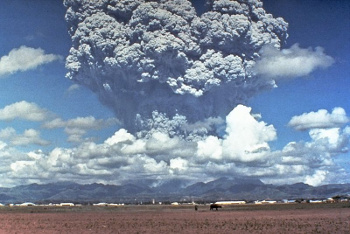Cooling with Aerosols
February 18, 2019
There are quite a few cautionary
adages. Two that come easily to mind are, "
A stitch in time saves nine," and "
An ounce of prevention is worth a pound of cure." With all this
folk wisdom at hand, it's surprising that we haven't done much to prevent
global warming, a
phenomenon that's becoming a serious
financial problem; as, for example, from
rising sea level and
weather extremes. There will also be a diminished
quality of life from excessive
temperature in many places.

Global warming data, which is incontrovertible, and several extrapolations from climate models. (Left image from the UK National Meteorological Service, and right image from Wikimedia Commons. Click for larger image.)
While some
governments have ignored
scientists' warnings to enact measures to stop or reduce global warming, they may soon
petition us for a "ninth stitch" or "one pound" remedy. Scientists have been investigating possible
technological fixes for global warming.[1] The most benign of these is
afforestation; that is, a huge, global-scale
tree-
planting effort. Another such
biological method is
ocean fertilization, accomplished by adding
nutrients such as
iron to the
ocean to increase
phytoplankton production as a way to capture
carbon dioxide from the
atmosphere.
Non-biological methods of
carbon sequestration include
mineral carbonation in which
pulverized minerals are exposed to the atmosphere to react with carbon dioxide, then finally burying the
reaction products or dumping them into the ocean.[1] Dissolved
limestone,
silicate, or
calcium hydroxide can be dumped into the ocean to have the same effect.[1] Machines can be constructed to
remove carbon dioxide directly from the air for sequestration.[1] All these activities involve an expenditure of
energy that might contribute to the global warming they're trying to mitigate.
Some methods seem impractical,
expensive, and more like
science fiction. These include parking an
asteroid near
Earth and blasting its surface to create a
sunlight-
blocking cloud of
dust, and
launching innumerable small
mirrors into
space to
deflect the
Sun's rays. Some
down-to-earth methods seem more practical, such as
frothing portions of the oceans to create a white
foam of
microbubbles that
reflects sunlight. This could be done using
pumps attached to
cargo ships; but, like other methods, the energy expenditure would be huge, and it would increase the global warming it was intended to stop.
Nature has accomplished some global cooling on its own. An
eruption of
Mount Pinatubo in the
Philippines in 1991 caused about a
degree Fahrenheit (0.5
°C) cooling that lasted about two years.[1] The cause of this was the vast quantity of
sulfur dioxide forced into Earth's upper atmosphere by the
volcano. These
sulfur aerosols form a whitish
haze in the
sky, thereby dimming sunlight to cause a cooling effect. These
particles also
radiate absorbed energy in the
infrared, but this happens at high
altitude, so the
heat is lost to space.

Mount Pinatubo eruption, June 12, 1991.
This photograph was taken from the east side of Clark Air Base on Luzon island, the Philippines
(Photo by Dave Harlow of the United States Geological Survey, via Wikimedia Commons.
We don't need to find ways to cause volcanic eruptions to produce this outcome. As a 2012 study revealed, atmospheric
particulates had offset global warming for several
decades prior to passage of the
US Clean Air Act in 1963. This
legislation reduced
sulfate emission from
coal-fired power plants, the cause of
acid rain in the
Eastern United States.
This particulate pollution created a cold patch that temporarily obscured the effects of
global warming.[2] The effect was localized to this region, since these particulates were generated locally and remained in the atmosphere for only about a week. While
global mean temperature rose about 0.8 °C from 1906 to 2005, temperatures in the Eastern United States decreased 1 °C from 1930-1990.[3-4] The
aerosols reduced
solar heating power by as much as two
watts per
square meter.[4]
One strange process in atmospheric aerosols was discovered in 2011 at
CERN in the first
experiment using a
particle accelerator for
atmospheric science.[5-6] The
CERN Proton Synchrotron was used as a source of simulated
cosmic rays, and it was discovered that atmospheric
ionization by cosmic rays increases the formation of aerosol particles by up to a factor of 10.[6]
Can aerosol injection be a possible means to put a stop to global warming, at least until all world governments come to their senses? How could it be done, and how expensive would this be? These are questions answered in a recent
open access paper in
Environmental Research Letters by
Wake Smith of
Yale University and
Gernot Wagner of
Harvard University.[7-8]
These
authors reviewed to costs and technologies needed to deliver
sulfates into the lower
stratosphere at
altitudes of about 20
kilometers, a method termed
stratospheric aerosol injection (SAI).[7-8] Such a large scale,
hypothetical solar geoengineering project would be fully functional 15 years from now. Their assessment is that this would be possible with available high-altitude
aircraft, but it would be better done with aircraft that were purpose-built.[8]
Interestingly, they also examined whether such an aircraft-based program could be kept
secret. They argue that the required thousands of annual flights of airliner-sized aircraft from an international array of bases could not be concealed.[7-8] Says study author, Wake Smith,
"No global SAI program of the scale and nature discussed here could reasonably expect to maintain secrecy. Even our hypothesized Year One deployment program entails 4000 flights at unusually high altitudes by airliner-sized aircraft in multiple flight corridors in both hemispheres. This is far too much aviation activity to remain undetected, and once detected, such a program could be deterred."[8]
The goal of the hypothetical SAI program is a halving of the
anthropogenic effect of global warming in fifteen years.[7] Although a previous study assumed that modification of existing aircraft would be effective in such an activity, this study concludes that purpose-built, high payload, high-altitude tankers are needed, but these could be built.[7] The average annual cost of the program would be about $2.25 billion for the first fifteen years. The first year would require about 4,000 flights, but the number of flights would need to increase by about 4,000 per year after that.[7]

Space elevator.
If space elevators are ever perfected, they might be an ideal method for hoisting
sulfur into the
stratosphere.
They can be used for the short jaunt to the stratosphere in between raising objects into
orbit.
(Artist's impression by
Liftport, via
Wikimedia Commons)
While a billion dollars sounds like a lot of money, present estimates of the annual cost of global warming is in the tens of billions of dollars per year.[9] The problem, of course, is that the costs do not appear to many to be directly attributable, and that's why some governments and
industries aren't alarmed.
The specifications for the purpose-built airship were developed in consultation with several
aerospace and
aircraft engine companies. Says Smith,
"It's equivalent in weight to a large narrow body passenger aircraft. But to sustain level flight at 20 kms, it needs roughly double the wing area of an equivalently sized airliner, and double the thrust, with four engines instead of two. At the same time, its fuselage would be stubby and narrow, sized to accommodate a heavy but dense mass of molten sulfur rather than the large volume of space and air required for passengers."[8]
The
development cost for this new aircraft is estimated to be less than $2 billion, and a further $350 million is needed to develop modifications for existing
low-bypass engines.[8] There would be eight aircraft in the first year, rising to just under a hundred within fifteen years. While only 4,000 annual missions would happen in the first year, there would be more than 60,000 annual missions in year fifteen.[8]
References:
- Melissa Hogenboom, "Are ideas to cool the planet realistic?" BBC News, September 20, 2013.
- Caroline Perry, "'Warming hole' delayed climate change over eastern United States," Harvard School of Engineering and Applied Sciences Press Release, April 26, 2012.
- E. M. Leibensperger, L. J Mickley, D. J. Jacob, W.-T. Chen, J. H. Seinfeld, A. Nenes, P. J. Adams, D. G. Streets, N. Kumar and D. Rind,"Climatic effects of 1950–2050 changes in US anthropogenic aerosols – Part 1: Aerosol trends and radiative forcing," Atmos. Chem. Phys., vol. 12 (2012), pp. 3333-3348.
- E. M. Leibensperger, L. J Mickley, D. J. Jacob, W.-T. Chen, J. H. Seinfeld, A. Nenes, P. J. Adams, D. G. Streets, N. Kumar and D. Rind,"Climatic effects of 1950–2050 changes in US anthropogenic aerosols – Part 2: Climate response," Atmos. Chem. Phys., vol. 12 (2012), pp. 3349-3362.
- Jasper Kirkby, et al., "Role of sulphuric acid, ammonia and galactic cosmic rays in atmospheric aerosol nucleation," Nature, vol. 476, no. 7361 (August 25, 2011), pp. 429-433.
- Kathryn Grim, "Cloud-formation study at CERN to influence climate models," Symmetry Magazine (Fermilab/SLAC), August 25, 2011.
- Wake Smith and Gernot Wagner, "Stratospheric aerosol injection tactics and costs in the first 15 years of deployment," Environmental Research Letters, vol. 13, no. 12 (November 23, 2018), Article no. 124001, https://doi.org/10.1088/1748-9326/aae98d. This is an open access article with a PDF file here.
- Could an anti-global warming atmospheric spraying program really work, IOP Publishing Press Release, November 22, 2018.
- Kari Paul, "Climate change has cost the government $350 billion — here’s what it will cost you," MarketWatch, November 26, 2018.
Linked Keywords: Adage; a stitch in time saves nine; an ounce of prevention is worth a pound of cure; folklore; folk wisdom; global warming; phenomenon; finance; financial; rising sea level; weather extremes; quality of life; temperature; data; incontrovertible evidence; extrapolation; climate model; UK National Meteorological Service; Wikimedia Commons; government; scientist; petition; technological fix; afforestation; tree; sowing; planting; biology; biological; iron fertilization; ocean fertilization; nutrient; iron; ocean; phytoplankton; carbon dioxide; atmosphere of Earth; carbon sequestration; mineral carbonation; pulverizer; pulverize; mineral; chemical reaction; product (chemistry); limestone; silicate mineral; silicate; calcium hydroxide; carbon dioxide removal; direct air capture (DAC); energy; expense; expensive; science fiction; asteroid; Earth; sunlight; opacity (optics); dust; rocket launch; mirror; outer space; reflection (physics); deflect; sun; ray (optics); down-to-earth; frothing; foam; microbubble; pump; cargo ship; Nature; volcanic eruption; Mount Pinatubo; Philippines; degree Fahrenheit; celsius; °C; stratospheric sulfur aerosol; sulfur dioxide forced into Earth's upper atmosphere; volcano; sulfur; aerosol; haze; sky; particle; black-body radiation; radiate; absorption (electromagnetic radiation); absorb; infrared; altitude; heat; east; Clark Air Base; Luzon island, the Philippines; United States Geological Survey; particulate; decade; US Clean Air Act; legislation; sulfate; fossil-fuel power station; coal-fired power plants; acid rain; Eastern United States; global mean temperature; solar energy; solar heating power; watt; square meter; CERN; experiment; particle accelerator; atmospheric science; CERN Proton Synchrotron; cosmic ray; ionization; open access journal; open access paper; Environmental Research Letters; Wake Smith; Yale University; Gernot Wagner; Harvard University; author; sulfate; stratosphere; altitude; kilometer; stratospheric aerosol injection; hypothesis; hypothetical; solar; geoengineering; aircraft; secrecy; secret; hemispheres of Earth; anthropogenic greenhouse gases; anthropogenic effect of global warming; space elevator; orbit; Liftport; industry; aerospace; aircraft engine; company; weight; airliner; passenger aircraft; wing; area; thrust; fuselage; density; dense; molten; volume; passenger; research and development; bypass ratio; low-bypass.